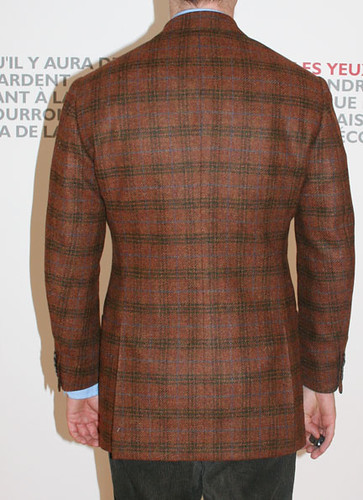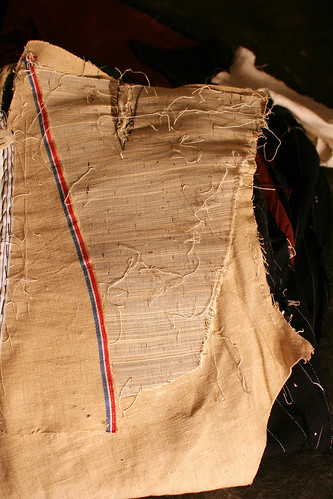Wow. It’s been a while. Let me start by wishing everyone a happy new year!
In the past six weeks I had been home all of five days, and non-consecutive ones at that so I’m way behind in all of my projects. The Ariston coat is long-finished but I need to photograph it and now I have a small pile of cloth to cut.
J&J Minnis was having a sale- the Crown Classics bunch was being offered at twenty pounds a meter plus VAT. So it’s time for another experiment.
Some time ago I experimented with drape, referencing a draft manipulation published by Whife in the Modern Tailor, Outfitter and Clothier. I had seen a number of published texts on the construction of a drape coat but had never handled the real thing so I kind of made things up as I went along, in terms of construction. The finished result was this.


Some of the details were goofy but the silhouette wasn’t bad.
Then I bought this vintage Anderson & Sheppard coat and learned a few things.

Most particularly, about how the drape in the chest is achieved by cutting the haircloth away from the armhole.

So this experiment is two-fold. First, the piece that I bought from Minnis is dark brown with a chalk stripe. I have never owned a brown suit and I’m not sure if I will like it or not. One way to find out, right?
Second, I will try this drape thing out again, but this time with an eye on the A&S coat. I like the shape and the flare to the skirt, though it’s perhaps verging on costume. The one thing I’m not really sure about is the chest. While I agree that the chest emphasis flatters me, as in the first attempt, I don’t think I can stomach a proper drape, with the haircloth cut away from the armhole, on a suit. I think I’m just too stuck in my ways for that. So I may keep the full haircloth in the chest. At which point it begins to resemble a Tom Ford cut.
Hmm.
We know that he was a customer of A&S before starting his own men’s line. So it’s very possible he went through the same thought process- extend the shoulder a bit and emphasize the chest to create the illusion of more waist suppression but build the chest up with a good amount of haircloth so that it’s clean and not sloppy. I’ve heard people moan about the fact that he was just copying this one or that one, but really, who isn’t inspired by somebody else? A&S was “inspired” by Scholte who was “inspired” by military uniforms…
One last question mark that remains in my head. Normally when underpressing the fronts, we keep the stripes closest to the armhole completely straight from the waist up to the top, working the chest forward toward center front. Since the objective of the traditional drape cut was to have a fold of cloth near the armscye, I figured that working the chest forward would negate that fullness near the scye and on the last coat I didn’t straighten them out. It seemed to work, but this time I think I’ll stick to the rules about stripes and see what happens.
So in all a lot of risks and a good chance I’ll end up not liking the suit. But at twenty pounds a meter at least it’s not an expensive risk, and worth the investment for whatever I might learn out of the process.
EDIT
My bad- I should have been more clear about what I mean by "drape". I'm not referring to the drape of the cloth or the patternmaking technique of draping, but to a style of coat that was created at the turn of the last century, was very popular in the thirties and virtually disappeared in the fifties. A primer, as well as the draft manipulation used for the last garment can be found here.
EDIT
In response to a question about underpressing the fronts, the stripes act as a guide for the correct pressing, and this is a critical step before basting the canvas. The stripes nearest the scye must run absolutely straight from the shoulder down to the waist line (this will cause a distortion in the stripes forward of the dart- this is normal). The stripes closest to center front must run straight from the waist down to the hem. This has the effect of crookening the shoulder point a tiny bit during pressing, but is separate from the issue of whether it is a straight-cut or crooked-cut coat. Hope this is a bit clearer now.









21 comments:
Jeffery, I really like your new jacket. My only question is about what looks like extra fabric in the back toward the middle of the armseye. What is the purpose of this?
Gita
happy new year mr d! bring on the experiment!
A pretty darn good result for a first attempt at draping a jacket - without seeing a side shot of your sleeves - I particularly like the shaping of these. The brown suit is an unusual sight I'd agree, but by no means out there. I'm looking forward to seeing the experiment's end results.
Gita- that extra fabric is the drape.
Poppykettle- actually, it was a flat pattern, not a draped pattern. See my edit above for clarification. Sorry.
Wow, what an amazing job you have done on this coat! The fit is perfection from what I see in these photos and as for the armhole situation, that's something I guess you'll continue fiddling with as I think we all have our "things" right?
(Just found your blog and can't wait to see more!)
I can't say I like it (on you). It does not make a smaller waist -it does makes an untidy upper body.
lg
heidi
I'm looking forward to seeing the results, but I have a question.
First off, two observations.
I have a sportscoat, cut to "drape" by a tailor who was not really familiar with the drape system. While I like it, one aspect which I am not keen on is the fact that the swelled chest tends to collapse, i.e. it tends to drape in the wrong place, just level with the breast pocket on the left and the same location right.
Although it is hard to be certain from your photo's, it looks as if your coat may be attempting to do the same.
So the question is, presumably cutting the haircloth away at the scye would be to ensure that the coat only drapes at that point, given that the remaining canvas/haircloth is fairly soft. If you leave the haircloth cut right up to the scye, is there a risk that, as described for my coat, the drape may tend to "wander"?
Best regards
Rob
Jeffery, happy new year to you. Super excited for this project! A few questions if you don't mind. Could you clairify your "big question mark" as you put it. About the stripes and such. I remember reading on the London Lounge Ed Deboise saying that stripes that run diaganol from the scye was an indication of a crooked neck point, whereas if they are more parallel to the scye it was an indication of a striaghtened neck point. Does this have any barring on what you are saying?
Also, I think the comments to this, particularly by the women posters seems to have a totally different idea of what drape is. In your edit you mention drape in "patternmaking" are you referring to more of dressmaking? Could you shed some light on other kinds of uses of the term for us guys who only know about suit silhouette? Thanks so much.
Also, I am curious to see how a more modern A&S jacket is constructed compared to the model that you have. Apparently their style of cutting has changed quite a bit.
@Rob- I'm not sure that the drape can be properly fixed in one spot. Cutting the haircloth away may help but I don't have a definitive answer.
@Christopher- regarding the stripes, it's a different issue than the one Edwin was describing. A separate post is probably required. Same for the concept of draping. That would actually be a really good post, I think.
Can't really help you with the A&S as I haven't seen the insides of a more recent one. I can say that I have seen Mr. Hitchcock wearing some nice things lately. Take that for what it is worth.
Nice work, but I think the pagoda shoulders (and everything else that comes with them) suit you better... But then, again, 'drape' as a subject matter is a very slippery slope, as we both know! ;)
--the drape can be properly fixed in one spot--
maybe you can fix the draped area with basting stitches, which you relase after the haircloth and the sleeve is sewed in?
lg
heidi
I've heard that Tom Ford is much inspired by Edward Sexton (my idol), whose cut I think is quite opposite to drape/AS. The recent Tom Ford suits I've seen are very close to the Nutters cut.
Anders.
I think your experiment came out brilliant! I also love the choice of fabric and the pattern! You're really talented!
This blog is so fantastic, well done! Please check mine out and follow if you like it! I promise to return the favour!
Thanks!
http://foreverfredastaire.blogspot.com/
A question about the darts. I suppose this doesn't really matter, but I notice you used a regular sidebody as opposed to the long front dart you used on the previous drape coat. Any particular reason? Pattern matching?
Also, as I understand it (feel free to correct me if I'm wrong), the underarm dart on a drape coat stops short of the armhole. Yours extends all the way through. Why is that?
@Benjamin- Instead of running the front dart all the way to the hem, you can just split off the side body like I have done- it has the exact same effect and is less distracting than the long front dart. Likewise you can achieve the same effect in the underarm using a dart or a seam.
J
I found this blog entry at Steven Hitchcock's. You can clearly see the cut of the horsehair here.
http://www.thesavilerowtailor.co.uk/2011/02/a-day-in-the-life-of-steven-hitchcock/
Thanks for a great blog,
Anders.
Honestly I like that checkered suit, and I want to wear that in my wedding.
Hi Jeffery,
Did anything come of this? It would be interesting to see a follow up.
Best regards
Rob
"Wow, what an insightful and well-researched blog! Your attention to detail and thorough analysis truly make it stand out from the rest. Kudos to you!"
Djerf Avenue Coupon Code
"Your blog's commitment to promoting inclusivity and celebrating diversity is incredibly refreshing. Your platform serves as a safe space for people from all walks of life to come together and learn from one another."
Fideliti Childcare Vouchers
Post a Comment